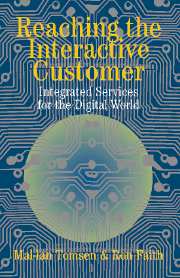7 - Targeting the Interactive Consumer
Published online by Cambridge University Press: 11 August 2009
Summary
Consumers incorporate integrated services into daily routines when the benefits provided reflect their real needs. Focusing exclusively on enabling technologies rather than the customer needs is a common mistake made by designers of new devices and applications. While technology enables companies to provide new classes of integrated services, attention to classic product marketing processes leads to the integrated service's success in the marketplace. The ongoing cycle of consumers adopting new devices, developing new behaviors, and forming new expectations results in a constantly changing market. New customers with shifting expectations provide significant challenges to both the designers and marketers of integrated services. Focusing on customer needs rather than the cool new technology while designing and packaging integrated services helps ensure success for an integrated service.
After reading this chapter, you should have a good understanding of the following topics:
The role of product marketing for integrated services
The roles that context, cost, and clear communication play in the success of integrated services
The characteristics of change in integrated services
BACK TO BASICS
It can sometimes be hard to believe that simple rules compose the heart of an integrated service's complex array of technologies, business models, and consumer behavior. Peter Drucker wrote that the two primary functions of a company are marketing and innovation. Everything else is simply a cost to the business. While the most visible aspect of marketing is product advertising, product marketing is arguably the most important marketing function carried out for an integrated service.
- Type
- Chapter
- Information
- Reaching the Interactive CustomerIntegrated Services for the Digital World, pp. 139 - 156Publisher: Cambridge University PressPrint publication year: 2003



